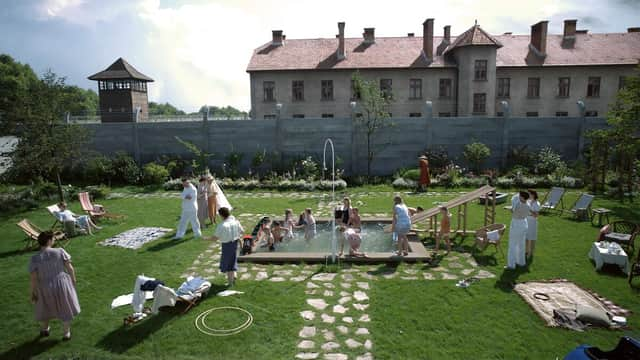Is The Zone of Interest a true story? How the film differs from Martin Amis' book, which characters are real


Released in British cinemas on Friday, February 2, The Zone of Interest is only British director Jonathan Glazer's fourth film in 25 years - following 'Sexy Beast', 'Birth', and 'Under The Skin'.
A tough watch, it follows the commandant of the Auschwitz Nazi death camp, Rudolf Höss, and his wife as they build a life of plenty for themselves and their five children directly next to the facility in which hundreds of thousands of people were murdered.
Advertisement
Hide AdThe title of the film is taken directly from a work of fiction on which it is loosely based, but that doesn't mean that what is seen on screen didn't happen.
Here's what you need to know after seeing the film.
Where did Jonathan Glazer get the idea for The Zone of Interest from?
Glazer was inspired by the 2014 book of the same name written by English author Martin Amis, who died in 2023. It was Amis' 14th novel and was well-received critically, with many saying it was his best novel since his 1980s heyday when he wrote his best-known works 'Money' and 'London Fields'. It was shortlisted for the £25,000 Walter Scott Prize for historical fiction.
How does the film differ from the book?
It's fair to say that, other than taking a basic concept from Amis' novel, Glazer has gone his own way with the film adaptation. The Amis book is set in Auschwitz and tells the story of a Nazi officer who falls in love with the camp commandant's wife. The commandant and his wife are named Paul and Hannah Doll and are fictionalised versions on real-life camp commandant Rudolf Höss and his wife. The story is told in three sections from three different narrative points of view - that of of the officer Angelus Thomsen, the commandant Paul Doll, and death camp prisoner Szmul Zacharias. Much of the tone of the novel is darkly comic.
Glazers' film on the other hand is far less interested in humour or plot and instead is a study of the real-life Rudolf Höss and his wife Hedwig as they build a life in a house that backs onto the high walls of Auschwitz. When Höss is forcibly promoted he must leave his home and his family behind to work in Berlin on a project to increase the efficiency of transporting Jews to the camp. Throughout the film there are reminders of the banality of evil, as they go about their daily life seemingly oblivious of the screams, gunfire and ash clouds from the camp.
Is The Zone of Interest a true story?
The film of The Zone of Interest is certainly more true to history than the book. It is factually accurate that Auschwitz commandant Rudolf Höss and his wife Hedwig lived in an idyllic two-story villa with landscaped gardens in the shadow of the camp, although with two children rather than five. The house itself is an accurate recreation of the Höss home, which still stands, and was even built close to the original property. In interviews Glazer has explained: “What (production designer) Chris (Oddy) built there is really a direct simulation of the house and garden and its proximity to the camp was essential for us. There's no fantasy staging going on. You're looking at how they lived.”
When it comes to the portrayal of the personal lives of the Höss family there are few records to rely upon, but Glazer and his team spent three years working with the Auschwitz and Birkenau State Museum and Memorial before starting filming. They studied pictures and first hand testimony from victims and survivors to build up as accurate a picture of the family as possible. Of course the individual conversations are fiction, as is Hedwig's mother's reaction to their living situation.
Advertisement
Hide AdWhile the timelines may not be entirely accurate, it's true that Rudolph Höss was transferred to a different post - that of deputy inspector of all concentration camps - in 1945 and there is testimony from the family's gardener that Hedwig was angry about a potential move, saying "she'd have to be carried out rather than leave voluntarily". The line is used in the film to chilling effect.
The operation named after Höss portrayed in the film is also true. Operation Höss saw 430,000 Hungarian Jews transported to the camp and killed in just 56 days.
What happened to Rudolph Höss?
Advertisement
Hide AdOne thing that the film does not portray is what happened to Rudolph Hess after the events of the movie.
At the end of the war the Höss family went into hiding, with Rudolph adopting the name Franz Lang and working as a gardener. In 1946 he was tracked down by Nazi hunter Hanns Alexander, who positively identified him by an inscription on the inside of his wedding ring. He testified at the International Military Tribunal at Nuremberg where he admitted to his crimes (although quibbled over the numbers - claiming he murdered two and a half million people, rather than the three and a half million he was accused of). He was handed over to Polish authorities who tried him for murder and sentenced him to death. He was hanged on April 16, 1947, next to the crematorium of Auschwitz where so may of his victims ended up.
What does the phrase 'The Zone of Interest' mean?
The phrase comes from the German word “Interessengebiet", which was a term used to refer to the restricted zone around the Auschwitz Nazi death camp by Nazi officers. The direct translation of the term means 'an area of interest' in an exciting and intriguing way, echoing the way the characters in the film see the 'zone'.
Comments
Want to join the conversation? Please or to comment on this article.